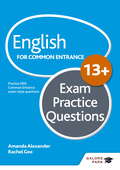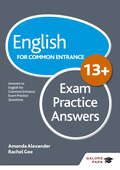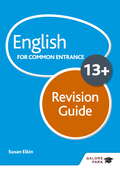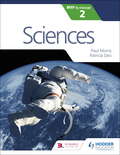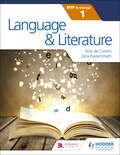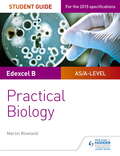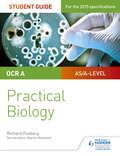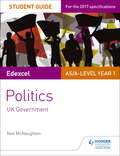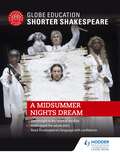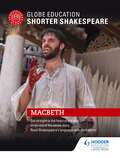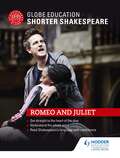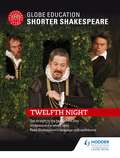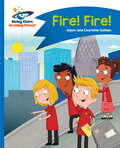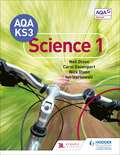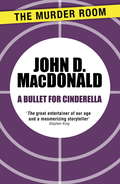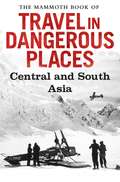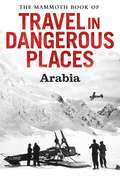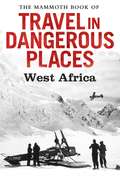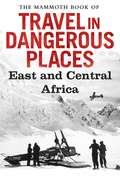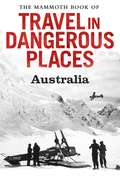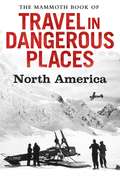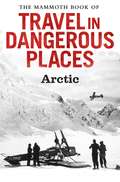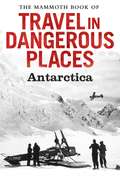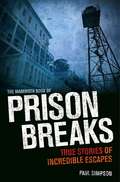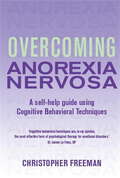- Table View
- List View
English for Common Entrance at 13+ Exam Practice Questions
by Amanda Alexander Rachel GeeThis book provides a wealth of comprehensive practice exercises in the format of the ISEB Common Entrance exam at both Level 1 and 2. A varied selection of texts and poems has been selected to help pupils for the Reading sections of the exam, and there is a large bank of exercises for the Writing sections.Exam Practice Answers is available to accompany this title.- Endorsed by Independent School Examination Board (ISEB)- Features rigorous and realistic exam-style questions in the style of the ISEB Common Entrance exam - Provides extensive practice and guidance to help pupils achieve top marksAlso available in the English for Common Entrance at 13+ range:- English for Common Entrance 13+ Revision Guide (ISBN: 9781471875021)- English for Common Entrance Exam Practice Answers (ISBN: 9781471868993)
English for Common Entrance at 13+ Exam Practice Answers
by Amanda Alexander Rachel GeeThis book contains answers to all the questions in English for Common Entrance at 13+ Exam Practice Questions, accompanied with extensive advice and guidance to help achieve top marks.- Endorsed by Independent School Examination Board (ISEB)- Clean, clear layout for easy marking- Identifies areas requiring further attentionAlso available in the English for Common Entrance at 13+ range:- English for Common Entrance at 13+ Revision Guide (ISBN: 9781471875021)- English for Common Entrance at 13+ Exam Practice Questions (ISBN: 9781471868962)
English for Common Entrance at 13+ Revision Guide
by Susan ElkinAn essential revision resource for pupils working towards English Common Entrance at 13+. A full colour resource which holds the most up-to-date material and exam techniques. Throughout the book you will find revision tips and practical guidance on how to achieve top grades, as well as self- assessment questions to help pupils identify areas that need further study.- Endorsed by Independent School Examination Board (ISEB)- Consolidates all the key information required for Common Entrance at 13+- Provides practical guidance on improving written answers and exam technique- Includes advice on creative writing and how to write for practical purposes
Sciences for the IB MYP 2
by Paul Morris Patricia DeoA concept-driven and assessment-focused approach to Sciences teaching and learning.- Approaches each chapter with statements of inquiry framed by key and related concepts, set in a global context- Supports every aspect of assessment using tasks designed by an experienced MYP educator- Differentiates and extends learning with research projects and interdisciplinary opportunities- Applies global contexts in meaningful ways to offer an MYP Sciences programme with an internationally-minded perspectiveContents list1 Where are we now and where are we going? 2 How do we map matter?3 Who are we? 4 How can we find out? 5 How does our planet work?6 How do we respond to our world?
Language and Literature for the IB MYP 1
by Ana De Castro Zara KaiserimamA concept-driven and assessment-focused approach to Language and Literature teaching and learning.- Approaches each chapter with statements of inquiry framed by key and related concepts, set in a global context- Supports every aspect of assessment using tasks designed by an experienced MYP educator- Differentiates and extends learning with research projects and interdisciplinary opportunities- Applies global contexts in meaningful ways to offer an MYP Language and Literature programme with an internationally-minded perspective
Edexcel A-level Biology Student Guide: Practical Biology
by Dan FoulderEnsure your students get to grips with the core practicals and develop the skills needed to succeed with an in-depth assessment-driven approach that builds and reinforces understanding; clear summaries of practical work with sample questions and answers help to improve exam technique in order to achieve higher grades.Written by experienced teacher Martin Rowland, this Student Guide for practical Biology:- Help students easily identify what they need to know with a concise summary of required practical work examined in the A-level specifications.- Consolidate understanding of practical work, methodology, mathematical and other skills out of the laboratory with exam tips and knowledge check questions, with answers in the back of the book.- Provide plenty of opportunities for students to improve exam technique with sample answers, examiners tips and exam-style questions. - Offer support beyond the Student books with coverage of methodologies and generic practical skills not focused on in the textbooks.
OCR A-level Biology Student Guide: Practical Biology
by Richard FosberyEnsure your students get to grips with the core practicals and develop the skills needed to succeed with an in-depth assessment-driven approach that builds and reinforces understanding; clear summaries of practical work with sample questions and answers help to improve exam technique in order to achieve higher grades.Written by experienced teacher Martin Rowland, this Student Guide for practical Biology:- Help students easily identify what they need to know with a concise summary of required practical work examined in the A-level specifications.- Consolidate understanding of practical work, methodology, mathematical and other skills out of the laboratory with exam tips and knowledge check questions, with answers in the back of the book.- Provide plenty of opportunities for students to improve exam technique with sample answers, examiners tips and exam-style questions. - Offer support beyond the Student books with coverage of methodologies and generic practical skills not focused on in the textbooks.
Edexcel AS/A-level Politics Student Guide: UK Government
by Neil McnaughtonWritten by experienced author Neil McNaughton this Student Guide forfor Politics:-Identifies the key content you need to know with a concise summary of topics examined in the AS/A-level specifications-Enables you to measure your understanding with exam tips and knowledge check questions, with answers at the end of the guide-Helps you to improve your exam technique with sample answers to exam-style questions-Develops your independent learning skills with content you can use for further study and research
Globe Education Shorter Shakespeare: A Midsummer Night's Dream
by Globe EducationGet straight to the heart of Shakespeare's A Midsummer Night's Dream; students' confidence and understanding develop faster as they explore the plot, themes and Shakespeare's language, which is supported throughout this abridged play text from Globe Education.This title:- Reduces the length of the play by a third, while preserving the intricacies of the plot, enabling students to engage with the whole story in the class time available- Builds understanding of Shakespeare's language by providing a detailed glossary alongside the text for quick and easy reference, plus a range of language-focused activities- Offers a tried-and-tested approach to introducing Shakespeare, based on Globe Education's shortened 'Playing Shakespeare' productions that have been seen and appreciated by over 150,000 students- Helps students form their own personal responses to Shakespeare's A Midsummer Night's Dream, stimulated by stunning photographs from Globe productions and questions that reflect on context, characters and themes- Lays the foundations for GCSE success by including activities that target the skills needed for the assessment objectivesFree teacher supportShorter Shakespeare: A Midsummer Night's Dream is supported by free online teaching resources for each scene:- Teaching notes with guidance on how to approach the scene - Practical group activities to use in the classroom- Questions on language, context, themes, character and performance - Web links to extra resources including photographs from Globe productions, interviews with actors and contextual informationThis title is also accompanied by 10 video clips from Globe Education's shortened 'Playing Shakespeare' production of A Midsummer Night's Dream.
Globe Education Shorter Shakespeare: Macbeth
by Globe EducationGet straight to the heart of Shakespeare's Macbeth; students' confidence and understanding develop faster as they explore the plot, themes and Shakespeare's language, which is supported throughout this abridged play text from Globe Education.This title:- Reduces the length of the play by a third, while preserving the intricacies of the plot, enabling students to engage with the whole story in the class time available- Builds understanding of Shakespeare's language by providing a detailed glossary alongside the text for quick and easy reference, plus a range of language-focused activities- Offers a tried-and-tested approach to introducing Shakespeare, based on Globe Education's shortened 'Playing Shakespeare' productions that have been seen and appreciated by over 150,000 students- Helps students form their own personal responses to Shakespeare's Macbeth, stimulated by stunning photographs from Globe productions and questions that reflect on context, characters and themes- Lays the foundations for GCSE success by including activities that target the skills needed for the assessment objectivesFree teacher supportShorter Shakespeare: Macbeth is supported by free online teaching resources for each scene:- Teaching notes with guidance on how to approach the scene - Practical group activities to use in the classroom- Questions on language, context, themes, character and performance - Web links to extra resources including photographs from Globe productions, interviews with actors and contextual informationThis title is also accompanied by 10 video clips from Globe Education's shortened 'Playing Shakespeare' production of Macbeth.
Globe Education Shorter Shakespeare: Romeo and Juliet
by Globe EducationGet straight to the heart of Shakespeare's Romeo and Juliet; students' confidence and understanding develop faster as they explore the plot, themes and Shakespeare's language, which is supported throughout this abridged play text from Globe Education.This title:- Reduces the length of the play by a third, while preserving the intricacies of the plot, enabling students to engage with the whole story in the class time available- Builds understanding of Shakespeare's language by providing a detailed glossary alongside the text for quick and easy reference, plus a range of language-focused activities- Offers a tried-and-tested approach to introducing Shakespeare, based on Globe Education's shortened 'Playing Shakespeare' productions that have been seen and appreciated by over 150,000 students- Helps students form their own personal responses to Shakespeare's Romeo and Juliet, stimulated by stunning photographs from Globe productions and questions that reflect on context, characters and themes- Lays the foundations for GCSE success by including activities that target the skills needed for the assessment objectivesFree teacher supportShorter Shakespeare: Romeo and Juliet is supported by free online teaching resources for each scene:- Teaching notes with guidance on how to approach the scene - Practical group activities to use in the classroom- Questions on language, context, themes, character and performance - Web links to extra resources including photographs from Globe productions, interviews with actors and contextual informationThis title is also accompanied by 10 video clips from Globe Education's shortened 'Playing Shakespeare' production of Romeo and Juliet.
Globe Education Shorter Shakespeare: Twelfth Night
by Globe EducationGet straight to the heart of Shakespeare's Twelfth Night; students' confidence and understanding develop faster as they explore the plot, themes and Shakespeare's language, which is supported throughout this abridged play text from Globe Education.This title:- Reduces the length of the play by a third, while preserving the intricacies of the plot, enabling students to engage with the whole story in the class time available- Builds understanding of Shakespeare's language by providing a detailed glossary alongside the text for quick and easy reference, plus a range of language-focused activities- Offers a tried-and-tested approach to introducing Shakespeare, based on Globe Education's shortened 'Playing Shakespeare' productions that have been seen and appreciated by over 150,000 students- Helps students form their own personal responses to Shakespeare's Twelfth Night, stimulated by stunning photographs from Globe productions and questions that reflect on context, characters and themes- Lays the foundations for GCSE success by including activities that target the skills needed for the assessment objectivesFree teacher supportShorter Shakespeare: Twelfth Night is supported by free online teaching resources for each scene:- Teaching notes with guidance on how to approach the scene - Practical group activities to use in the classroom- Questions on language, context, themes, character and performance - Web links to extra resources including photographs from Globe productions, interviews with actors and contextual informationThis title is also accompanied by 10 video clips from Globe Education's shortened 'Playing Shakespeare' production of Twelfth Night.
Reading Planet - Fire! Fire! - Blue: Comet Street Kids
by Adam Guillain Charlotte GuillainComet Street Kids reading books follow the adventures of Rav, Asha, Tess and Finn, four of the residents of Comet Street. There are 72 exciting stories in the series that children won't be able to put down. It's time for the school trip ? to the Monument in London! The class are going to find out all about the Great Fire of London, but Tess thinks she's going to see a real fire. After climbing the 311 steps to the top, will she? Reading age: 5-6 years
AQA Key Stage 3 Science Pupil Book 1
by Nick Dixon Neil Dixon Carol DavenportEnsure that every student develops the maths, literacy and working scientifically skills they need to succeed with this skills-focused Pupil Book that contains a variety of activities, questions and real-world examples that are tailored to the Big Ideas and mastery goals of the AQA KS3 Syllabus. - Develop conceptual understanding with a variety of questions that require students to apply their knowledge to real-world scenarios.- Build working scientifically skills with various Enquiry activities matched to the AQA syllabus.- Test understanding and measure progress with factual recall questions developed around the ideas of Generalisations, Principles and Models.- Stretch knowledge and understanding with extend tasks linked to higher-order thinking skills - Compare, Evaluate and Predict.- Bridge the gap between Key Stages 2 and 3, with a focus on maths and enquiry skills and understanding scientific terminology.- Provides comprehensive support for non-specialist or less-confident teachers when used in conjunction with the online Teaching & Learning resources.Written in association with Sheffield Hallam University:The Science Education Team within Sheffield Institute of Education (SIoE), is one of the leading STEM education groups in Europe, with a worldwide reputation for knowledge exchange and research. SIoE leads national and international STEM education programmes covering curriculum and pedagogical design and development, widening participation to traditionally under-represented groups, and research in science education.
A Bullet for Cinderella
by John D. MacdonaldHer veneer was big city . . . But one look and you knew that Toni Raselle's instincts were straight out of the river shack she came from. I watched her as she toyed with the man, laughing, her tumbled hair like raw blue-black silk, her brown shoulders bare. Eyes deep-set, a girl with a gypsy look. So this was the girl I had risked my life to find. This was the girl who was going to lead me to a buried fortune in stolen loot.
The Mammoth Book of Travel in Dangerous Places: Central and South Asia
by John KeayAlarms amongst the Uzbeks - Alexander BurnesOf all the "forbidden" cities (Timbuktu, Mecca, Lhasa, Riyadh and so on) none enjoyed a more fearsome reputation that Bukhara in Uzbekistan. The first British Indian expedition, that of William Moorcroft in 1819-26, had never returned. Moorcroft's disappearance, like that of Livingstone or Franklin, posed a challenge in itself and preyed on the minds of his immediate successors. Heavily disguised and in an atmosphere of intense intrigue, Burnes and Dr James Gerard crossed the Afghan Hindu Kush in 1832 and approached the scenes of Moorcroft's discomfiture. They would both return; and "Bukhara Burnes" would become the most renowned explorer of his day.On the Roof of the World - John WoodIn 1937 Alexander Burnes returned to Afghanistan on an official mission. Amongst his subordinates was a ship's lieutenant who, having surveyed the navigational potential of the river Indus, took off on a mid-winter excursion into the unknown Pamirs between China and Turkestan. Improbably, therefore, it was John Wood, a naval officer and the most unassuming of explorers, who became the first to climb into the hospitable mountain heartland of Central Asia and the first to follow to its source the great river Oxus (or Amu Darya.)Exploring Angkhor - Henri MouhotBorn in France, Mouhot spent most of his career in Russia as a teacher and then in the Channel Islands. A philologist by training, he also took up natual history and it was with the support of the Royal Zoological Society that in 1858 he set out for South East Asia. From Siam (Thailand) he penetrated Cambodia and Laos, where he died; but not before reaching unknown Angkhor and becoming the first to record and depict the most extensive and magnificent temple complex in the world. His discovery provided the inspiration for a succession of subsequent French expeditions up the Mekong.Over the Karakorams - Francis Edward YounghusbandAs leader of the 1904-5 British military expedition to Lhasa and as promoter of the early assaults on Mount Everest, Younghusband came to epitomize Himalayan endeavour. To the mountain he also owed his spiritual conversion from gung-ho solider to founder of the World Congress of Faiths. His initiation came in 1887 when, as the climax to journey from Peking across the Gobi desert, he determines to reach India over the unexplored Mustagh Pass in the Karakorams - "the most difficult and dangerous achievement in these mountains so far" (S.Hedin).Trials in Tibet - Ekai KawaguchiBy the 1890's the capital of "forbidden" Tibet, unseen by a foreigner since Huc's visit, represented the greatest challenge to exploration. Outright adventurers like the dreadful Henry Savage Landor competed with dedicated explorers like Sven Hedin, all succumbed to to a combination of official vigilance and physical hardship. The exception, and the winner in "the race for Lhasa", was a Buddhist monk from Japan whose expedition consisted of himself and two sheep. Ekai Kawaguchi was supposedly a pilgrim seeking religious texts. His faith was genuine and often tested, as during this 1900 excursion into western Tibet; but he is also thought to have been an agent of the British government in India.
The Mammoth Book of Travel in Dangerous Places: Arabia
by John KeayEscape from Riyadh - William Gifford PalgraveA scholar and a solider, a Jesuit and a Jew, a French spy and a British ambassador- Palgrave was a man of contradictions, all of them highly compromised when in 1862-3, fortified by Pius IX's blessing and Napoleon III's cash, he attempted the first west- east crossing of the Arabian peninsular. To steely nerves and a genius for disguise he owed his eventual success; but not before both were sorely tested when, as a Syrian doctor, he became the first European to enter Riyadh. The desert capital of the fanatical Wahabis, dangerous for an infidel at the best of times, was then doubly so as the sons of the ageing King Feisal intrigued for power.Desert Days - Charles Montagu DoughtyDuring two years (1875-7) wandering in Central Arabia Doughty broke little new ground; dependant on desert charity, his achievement was simply to have survived. Yet his book, Arabia Deserta, was instantly recognized as a classic. Its eccentric prose proves well suited to that minute observation and experience of Bedouin life which was Doughty's main contribution to exploration. T.E. Lawrence called it "a bible of a kind"; both syntax and subject matter have biblical resonances, as in this description of a day's march, or rahla.
The Mammoth Book of Travel in Dangerous Places: West Africa
by John KeayAlone in Africa - Mungo ParkPark's 1795-7 odyssey in search of the Niger first awakened the world to the feasibility of a white man penetrating sub-Saharan Africa. But unlike his illustrious successors, this quiet tenant farmer's son from the Scottish Borders travelled alone; relieved of his meager possessions, he was soon wholly dependant on local hospitality. In what he called "a plain unvarnished tale" he related horrific ordeals with admirable detachment - never more tested than on his return journey through Bamako, now the capital of Mali.The Road to Kano - Hugh ClappertonIn one of exploration's unhappier sagas two Scots, Captain Hugh Clapperton and Dr. Walter Oudney, were saddled with the unspeakable Major Dixon Denham on a three year journey to Lake Chad and beyond. Clapperton mapped much of northern Nigeria and emerged with credit. Major Denham also excelled himself, twice absconding, then accusing Oudney of incompetence and Clapperton of buggery. Happily the Major was absent in 1824, after nursing his dying friend, Clapperton became the first European to reach Kano.Down the Niger - Richard LanderAs Clapperton's manservant, Lander attended his dying master on his 1825 expedition to the Niger and was then commissioned, with his brother John, to continue the exploration of the river. The mystery of its lower course was finally solved when in 1831 they sailed down through Nigeria to the delta and the sea. Unassuming Cornishmen, the Landers approached their task with a refreshing confidence in goodwill of Africans. It paid of in a knife-edge encounter at the confluence of the Benoue, although Richard subsequently paid the price with his life.Arrival in Timbuktu - Heinrich BarthBorn in Hamburg, Barth was already an experienced traveler and a methodical scholar when in 1850 he joined a British expedition to investigate Africa's internal slave trade. From Tripoli the expedition crossed the Sahara to Lake Chad. Its leader died but Barth continued on alone, exploring vast tract of the Sahel from northern Cameroon to Mali. Timbuktu, previously visited only by A.G. Laing and René Caillié, provided the climax as Barth, in disguise, approached the forbidden city by boat from the Niger.My Ogowé Fans - Mary KingsleySelf-educated while she nursed her elderly parents, Mary Kingsley had known only middle-class English domesticity until venturing to West Africa in 1892. Her parents had died and, unmarried, she determined to study "fish and fetish" for the British Museum. Her 1894 ascent of Gabon's Ogowé River (from Travels in West Africa, 1897) established her a genuine pioneer and an inimitable narrator. She died six years later while nursing prisoners during the Boer War.
The Mammoth Book of Travel in Dangerous Places: East and Central Africa
by John KeayAmong the Sudanese - James BruceBruce reached the source of the Blue Nile in 1771, a century before the search for the source of the White Nile became headline news. His descriptions of the cruelties and orgies at Gondar, the Ethiopian capital, were greeted with disbelief; so was his account of the Sudanese rulers, and their queens, at Sennar. He was later shown to be an accurate observer as well as the eighteenth century's most intrepid traveller.Not the Source of the Nile - Richard Francis BurtonIn Burton a brilliant mind and dauntless physique were matched with a restless spirit and a deeply troubled soul to produce the most complex of characters. Contemptuous of other mortals, including Speke, his companion and rival, he found solace only in the extremities of erudition and adventure. A Glimpse of Lake Victoria - John Hanning SpekeIn July 1858, while returning from Lake Tanganyika with Burton, Speke made a solo excursion to the north in search of an even larger lake reported by an Arab informant. Although partially blind and unable to ascertain its extent, he named this lake "Victoria" and boldly declared it the long sought source of the White Nile. The Reservoir of the Nile - Samuel White BakerAmongst professional explorers and big game hunters, none was as successful as Baker. A bluff and plausible figure, wealthy and resourceful, he conducted his explorations on the grand scale, invariably reached his goal and invariably reaped the rewards.Last Days - David LivingstoneLivingstone was nurtured in poverty and religious fervour. He reached southern Africa as a missionary doctor but, more suited to solitary exploration, edged north in a series of pioneering journeys into the interior. Encounters on the Upper Congo - Henry Morton StanleyStanley made his name as an explorer by tracking down Livingstone in 1871. But obscure Welsh origins, plus the adoption of US citizenship and professional journalism, did not endear him to London's geographical establishment. His response was to out-travel all contemporaries, beginning with the first ever coast-to-coast crossing of equatorial Africa. A Novice at Large - Joseph ThomsonBarely twenty and just out of Edinburgh University, Thompson was unexpectedly employed on the Royal Geographical Society's 1878 expedition to the Central African lakes. Unlike Burton he admired Africans; unlike Stanley he would not fight them. His motto - "he who goes slowly, goes safely; he who goes safely, goes far" - was never more seriously tested that when, just six weeks inland from Dar es Salaam, his first expedition lost Keith Johnston, its leader and Thompson's only European companion.
The Mammoth Book of Travel in Dangerous Places: Australia
by John KeayLandfall at Botany Bay - James CookThe son of a Yorkshire farm labourer, Cook won distinction as a naval hydrographer but was still a controversial choice to command a voyage of scientific observation to the Pacific in 1768. Its results, including the first coastal surveys of New Zealand and eastern Australia, led to a second voyage to the south Pacific and a third to the north Pacific, during which he was killed in a fracas with the Hawaiians. It was a tragic end for one whose humble origins disposed him to respect indigenous peoples. "They are far happier than we Europeans", he noted of Australia's aborigines following a brief encounter at Botany Bay (Sydney), the first European landing on the Pacific coast, in 1770.Escape from the Outback - Charles SturtAfter pioneering journeys to the Darling and Murray rivers, in 1844-5 Sturt headed north for the heart of Australia. Since the continent appeared to have few seaward draining rivers it was assumed that, alike Africa, it must boat an inland lake region; a boat was therefore included amongst the expeditions equipment. But Sturt failed to reach the geographical centre of the continent, and the largest stretch of water found was at Coopers Creek, later to figure so prominently in the endeavours of Burke and Wills. Sturt's painful retreat during the hottest summer on record formed a fitting prelude to the Wills saga.Death at Coopers Creek - William John WillsIn early 1861 Robert O'Hara Burke, William Wills and John King reached Australia's northern coast on the Gulf of Carpentaria, thus completing the first transcontinental crossing. Returning the way they had come, after four months of appalling hardship they staggered into Sturt's Coopers Creek where men and supplies had been left to await their return. They were just eight hours too late; the relief party, despairing of their return, had left that very morning. One of exploration's most poignant moments was followed by one of its most protracted tragedies as the expedition tried to extricate itself, failed, faded, and died. Only King survived; three months later he was discovered living with the aborigines; Will's heartbreaking journal was found lying beside his skeleton.To See the Sea - John McDouall StuartModest, dedicated, immensely tough and thoroughly congenial, Stuart was very much an explorer's explorer. With little support or fuss he began probing north from Adelaide in the late 1850's. In 1860 he was the first to reach the centre of the continent, thus completing the work of Sturt. Although Burke and Wills just beat him in the race to cross the continent, Stuart's 1862 route was much longer and more difficult; and he did actually reach the sea. He was also to return alive.
The Mammoth Book of Travel in Dangerous Places: North America
by John KeayFirst Crossing of America - Alexander Mackenzie"Endowed by nature with an acquisitive mind and an enterprising spirit", Mackenzie, a Scot engaged in the Canadian fur trade, resolved, as he out it "to test the practicability of penetrating across the continent of America". In 1789 he followed a river (the Mackenzie) to the sea; but it turned out to be the Arctic Ocean. He tried again in 1793 and duly reached the Pacific at Queen Charlotte Sound in what is now British Columbia. Although this was his first recorded overland crossing of the continent, Mackenzie was not given to trumpeting his achievement. In his narrative it passes without celebration and very nearly without mention.Meeting the Shoshonee - Meriwether LewisAs Thomas Jefferson's personal secretary, Lewis was chosen to lead the US government's 1804-5 expedition to explore (and to establish US interests) from Mississippi to the Pacific. Travelling up the Missouri river to the continental divide in Montana, Lewis left the main party under his colleague William Clark, and scouted ahead. With everything now dependant on securing the goodwill of the formidable Shoshonee, he showed admirable caution; but the issue was eventually decided by a fortuitous reunion between the Indian wife of one of his men and her long-lost brethren.
The Mammoth Book of Travel in Dangerous Places: Arctic
by John KeayFour Years in the Ice - John RossDisgraced and dishonored for his report of an imaginary mountain range blocking the most likely access to the North West Passage, in 1829 Ross returned to Canada's frozen archipelago to vindicate his reputation. He rounded the north of Baffin Island and entered what he named the Gulf of Boothia. Here the Victory, his eccentric paddle-steamer, became frozen to the ice. Through three tantalizingly brief summers the expedition tried to find a way out and through four long winters then endured the worst of Arctic conditions in a makeshift camp. In July 1832, with the ship long since abandoned, Ross made what must be their last bid to reach open water.Living off Lichen and Leather - John FranklinIn 1845, looking again for the North West Passage, two well-crewed ships under Franklin's command sailed into the Canadian Arctic and were never seen again. There began the most prolonged search ever mounted for an explorer. For Franklin had been lost before and yet had survived. In 1821, returning from an overland reconnaissance of the Arctic coast north of Great Slave Lake, he and Dr. John Richardson, with two Lieutenants and about a dozen voyageurs (mostly French), had run out of food and then been overtaken by the Arctic weather. Franklin's narrative of what is probably the grisliest journey on record omits unpalatable details, like the cannibalism of one of his men, the murder of Lieut. Hood, and Richardson's summary shooting of the murderer; but it well conveys the debility of men forced to survive on leather and lichen (triple de roche) plus that sense of demoralization and disintegration that heralds the demise of an expedition.Adrift on an Arctic Ice Floe - Fridtjof Nansen Norwegian patriot, natural scientist, and Nobel laureate, Nansen caught the world's imagination when he almost reached the North Pole in 1895. The attempt was made on skis from specially reinforced vessel which, driven into the ice, was carried from Siberia towards Greenland. The idea stemmed from his first expedition, an 1888 crossing of Greenland. Then too he had used skis and then too, unwittingly and nearly disastrously, he had taken to the ice. Arrived off Greenland's inhospitable east coast, he had ordered his five-man party to spare their vessel by crossing the off-shore ice floe in rowing boats. A task which he expected to take a few hours turned into an involuntary voyage down the coast of twelve days.The Pole is Mine - Robert Edwin Peary Born in Pennsylvania and latterly a commander in the US navy, Peary had set his sights on claiming the North Pole from childhood. It was not just an obsession but a religion, his manifest destiny. Regardless of cost, hardship, and other men's sensibilities, he would be Peary of the Pole, and the Pole would be American. Critics might carp over the hundreds of dogs that were sacrificed to his ambition, over the chain of supply depots that would have done credit to a military advance, and over the extravagance of Peary's ambition, but success, in 1909, came only after a catalogue of failures; and even then it would be disputed. Under the circumstances his triumphalism is understandable and, however distasteful, not unknown amongst other Polar travelers.
The Mammoth Book of Travel in Dangerous Places: Antarctic
by John KeayFarthest South - Ernest Henry ShackletonBorn in Ireland, Shackleton joined the merchant navy before being recruited for Captain Scott's 1901 expedition to Antarctica. He was with Scott on his first attempt to reach the South Pole and, though badly shaken by the experience, realized that success was now feasible. In 1907, with a devoted team but little official support, he launched his own expedition. A scientific programme gave it respectability but Shackleton was essentially an adventurer, beguiled alike by the challenge of the unknown and the reward of celebrity. His goal was the Pole, 90 degrees south, and by Christmas 1908 his four-man team were already at 85 degrees.The Pole at Last - Roald AmundsenAmundsen's 1903-6 voyage through North West Passage had heralded a new era in exploration. The route by then was tolerably well known and its environs explored. His vessel was a diminutive fishing smack, his crew a group of Norwegian friends, and his object simply to be the first to have sailed through. He did it because it had not been done and "because it was there". The same applied to his 1911 conquest of the South Pole. Shackleton had shown the way and Amundsen drew the right conclusions. The Pole was not a scientist's playground nor a mystic's dreamland; it was simply a physical challenge. Instead of officers, gentlemen and scientists, he took men who could ski and dogs that could pull; if need be, the former could eat the latter. The only real anxiety was whether they would forestall Scott.In Extremis - Robert Falcon ScottScott was chosen to lead the 1900-4 British National Antarctic Expedition. Its considerable achievements seemed to vindicate the choice of a naval officer more noted for integrity and courage than any polar experience, and, following Shackleton's near success, in 1910 Scott again sailed south intending to combine a busy scientific programme with a successful bid for the South Pole. On 17 January 1912 he and four others duly reached the Pole, indeed they sighted a real pole and it bore a Norwegian flag; Amundsen had got there 34 days ahead of them. Bitterly disappointed, soon overtaken by scurvy and bad weather, and still dragging sledges laden with geological specimens, they trudged back. The tragedy which then unfolded eclipsed even Amundsen's achievement and won them an immortality beyond the dreams of any explorer.
The Mammoth Book of Prison Breaks
by Paul SimpsonTrue stories of prison breaks including those of Frank Abagnale, whose story is told in Catch Me If You Can; Henri Charrière who claimed to have escaped from the supposedly inescapable Devil's Island - the true story as opposed to his questionable memoir, Papillon; Bud Day, said to be the only US serviceman ever to have escaped to South Vietnam; the six prisoners who escaped from Death Row in Mecklenburg Correctional Center; and Pascal Payeret, the French armed robber who escaped not once, but twice from French prisons with the help of a helicopter.
Overcoming Anorexia Nervosa: A Self-help Guide Using Cognitive Behavioral Techniques (Overcoming Ser.)
by Christopher FreemanA brand new cover for an invaluable self-help book on this life-threatening and widespread disorder
